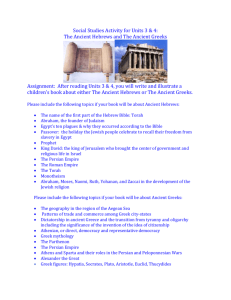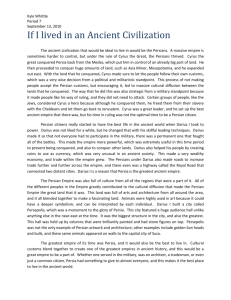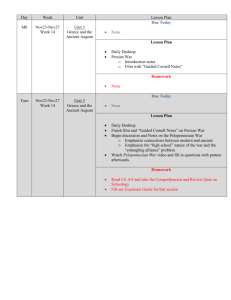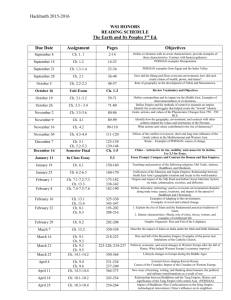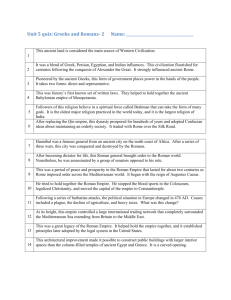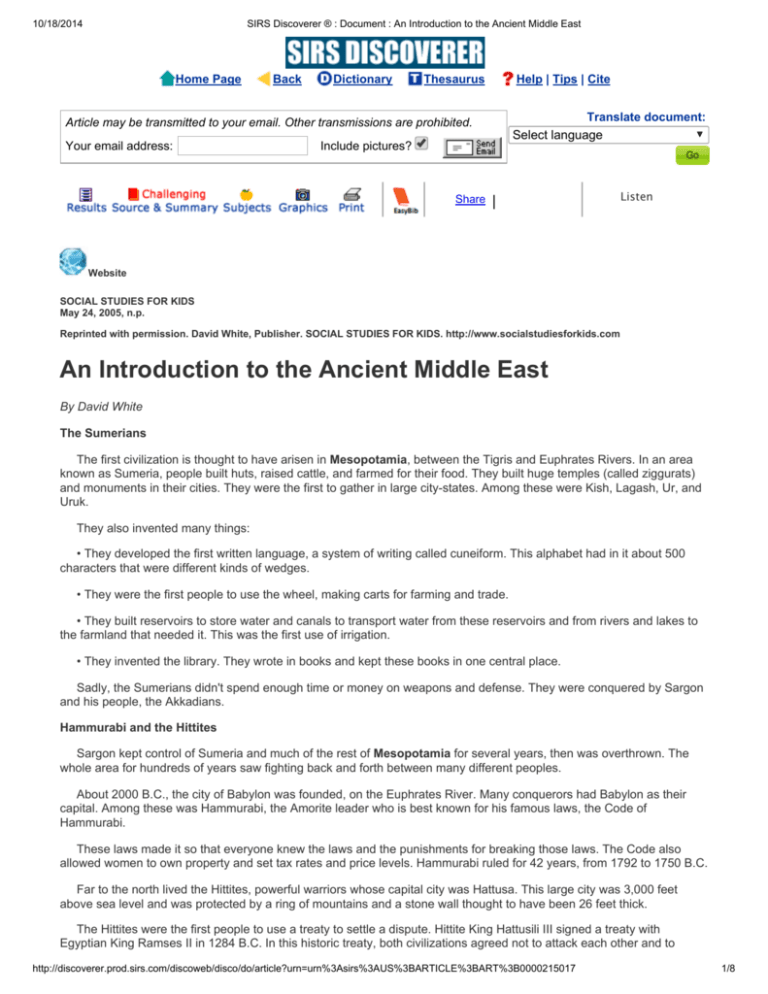
10/18/2014
SIRS Discoverer ® : Document : An Introduction to the Ancient Middle East
Home Page
Back
Dictionary
Thesaurus
Help | Tips | Cite
Translate document:
Select language
Article may be transmitted to your email. Other transmissions are prohibited.
Your email address:
Include pictures?
Share
Listen
Share
Share
onShare
on
facebook
on
twitter
on
gmail
stumbleupon
| Share
Website
SOCIAL STUDIES FOR KIDS
May 24, 2005, n.p.
Reprinted with permission. David White, Publisher. SOCIAL STUDIES FOR KIDS. http://www.socialstudiesforkids.com
An Introduction to the Ancient Middle East
By David White
The Sumerians
The first civilization is thought to have arisen in Mesopotamia, between the Tigris and Euphrates Rivers. In an area
known as Sumeria, people built huts, raised cattle, and farmed for their food. They built huge temples (called ziggurats)
and monuments in their cities. They were the first to gather in large city-states. Among these were Kish, Lagash, Ur, and
Uruk.
They also invented many things:
• They developed the first written language, a system of writing called cuneiform. This alphabet had in it about 500
characters that were different kinds of wedges.
• They were the first people to use the wheel, making carts for farming and trade.
• They built reservoirs to store water and canals to transport water from these reservoirs and from rivers and lakes to
the farmland that needed it. This was the first use of irrigation.
• They invented the library. They wrote in books and kept these books in one central place.
Sadly, the Sumerians didn't spend enough time or money on weapons and defense. They were conquered by Sargon
and his people, the Akkadians.
Hammurabi and the Hittites
Sargon kept control of Sumeria and much of the rest of Mesopotamia for several years, then was overthrown. The
whole area for hundreds of years saw fighting back and forth between many different peoples.
About 2000 B.C., the city of Babylon was founded, on the Euphrates River. Many conquerors had Babylon as their
capital. Among these was Hammurabi, the Amorite leader who is best known for his famous laws, the Code of
Hammurabi.
These laws made it so that everyone knew the laws and the punishments for breaking those laws. The Code also
allowed women to own property and set tax rates and price levels. Hammurabi ruled for 42 years, from 1792 to 1750 B.C.
Far to the north lived the Hittites, powerful warriors whose capital city was Hattusa. This large city was 3,000 feet
above sea level and was protected by a ring of mountains and a stone wall thought to have been 26 feet thick.
The Hittites were the first people to use a treaty to settle a dispute. Hittite King Hattusili III signed a treaty with
Egyptian King Ramses II in 1284 B.C. In this historic treaty, both civilizations agreed not to attack each other and to
http://discoverer.prod.sirs.com/discoweb/disco/do/article?urn=urn%3Asirs%3AUS%3BARTICLE%3BART%3B0000215017
1/8
10/18/2014
SIRS Discoverer ® : Document : An Introduction to the Ancient Middle East
protect each other if attacked by another civilization.
Phoenicians and Hebrews
About 1200 B.C. a seafaring civilization arose along the Mediterranean Sea. These were the Phoenicians, and their
boats carried traders and explorers alike. They carried customs and goods from one ancient civilization to another. They
are known for their alphabet, their papermaking, and their glassmaking.
The Phoenicians founded cities (among them Byblos, Sidon, and Tyre) but were more interested in trade than empire.
They also founded the city of Carthage, in northern Africa, in 814 B.C. This city would become the capital of a very
powerful civilization that would rival Rome for control of the Mediterranean world.
To the south of Phoenician territory was Canaan, a mountain-and-desert land that was home to the Hebrews.
Abraham led his people from the city of Ur to Canaan about 1900 B.C. The Hebrews, who had started out as traders,
became growers of wheat, fig, and olives and tenders of sheep. They stayed in Canaan for about 100 years, during which
time they organized themselves into the famous 12 Tribes. About 1800 B.C., a drought began, forcing the Hebrews to
move to Egypt.
Six hundred years later, the Hebrews were enslaved in Egypt. After a time, Moses led them out of slavery and across
the Sinai Desert, first to Mount Sinai, where he received the Ten Commandments, and then back to Canaan. Moses died
shortly before they arrived, but Joshua led them safely to what they called "the Promised Land."
The Hebrews elected Saul as their first king, and he ruled for several years. His death brought David to the throne.
David continued Saul's campaigns against the neighboring lands and made Jerusalem his capital. His son, Solomon,
ruled for many years; when he died, the Hebrews split into two kingdoms: Israel in the north and Judah in the south.
Assyrians and Chaldeans
The area of Mesopotamia once ruled by the Sumerians and the Akkadians continued to be ruled by one empire after
another. About 1100 B.C., this began to change, with the arrival of the Assyrian Empire.
(See map, "Assyrian Empire and the Eastern Mediterranean.")
The Assyrians brought with them iron weapons and a will to fight and win not seen
before. The iron weapons were particularly effective because iron was stronger than
any other metal. The Assyrians had taken the Hittite process of smelting and applied it
to iron. They also trained their warriors to fight in divisions called infantries. The result
was a well-trained fighting machine armed with top-grade weapons. By 665, the
Assyrians controlled most of Mesopotamia, Phoenicia, and Canaan.
The Assyrians had many kings; the most famous was Ashurbanipal, who started a
library that eventually contained 25,000 tablets of hymns, stories, and biographies.
Among these tablets was the story of Gilgamesh, one of the world's first epic
adventure stories.
Assyrian Empire and the
Eastern Mediterranean
In time, however, the Assyrian Empire grew too large and was taken over bit by bit, mostly by a people called the
Chaldeans, who captured the Assyrian capital of Nineveh in 612 B.C.
The Chaldeans' most famous ruler was Nebuchadnezzar, who ruled from 605 to 562 B.C., and who had built the
Hanging Gardens of Babylon, one of the Seven Ancient Wonders of the World. He also conquered Jerusalem and forced
the Hebrews to move to Babylon. (This is known in the Jewish and Christian traditions as the Babylonian Captivity.)
The Chaldean Empire was one of several empires that had Babylon as its capital. In time the Chaldeans called
themselves the Babylonians. They were one of the first people to come up with ideas that shaped our modern
understanding of mathematics, and they beliefs formed the basis of what we now call astronomy.
Persians
The last of the great ancient Middle Eastern empires (and the largest) was Persia, with its capital of Persepolis.
(See map, "Persian Empire Circa 500 B.C.")
Cyrus the Great was the first great Persian ruler. He ruled from 559 to 530 B.C.
and conquered Asia Minor and Mesopotamia. King Darius I, called Darius the Great,
extended the empire as far east as the Indus River in India. Darius divided his empire
into 20 provinces, and the ruler of each province was called a satrap.
http://discoverer.prod.sirs.com/discoweb/disco/do/article?urn=urn%3Asirs%3AUS%3BARTICLE%3BART%3B0000215017
2/8
10/18/2014
SIRS Discoverer ® : Document : An Introduction to the Ancient Middle East
Persian Empire Circa 500
B.C.
The Persians had a vast empire, and they built roads to connect the different parts.
Like the Roman roads, Persian roads allowed traders and troops to move more
quickly from one part of the empire to another. One road, the Royal Road, stretched
more than 1,600 miles, from Sardis in Asia Minor to Susa, near the Persian Gulf. They also built a canal to connect the
Nile River to the Red Sea.
Three kings named Darius ruled the Persian Empire. Two of them did battle with Alexander the Great. The third fought
against the Greeks in the Persian Wars. Another Persian ruler, Xerxes, also invaded Greece but was forced to retreat as
well.
To avenge the loss of many Greeks during the Persian Wars, Alexander the Great invaded and, finally, conquered the
Persian Empire, in 330 B.C.
Who/What/Where/When
Tigris River
Definition: River that was a boundary of Mesopotamia, or the "land between the rivers" (Tigris and Euphrates). The
Tigris was the eastern of the two rivers and flowed from a source deep in the Armenian mountains all the way to the
Persian Gulf, about 1,200 miles. Both rivers were the lifeblood of Mesopotamian civilizations, giving them water and a
vehicle for their trade and defense.
Euphrates River
Definition: River that was a boundary of Mesopotamia, or the "land between the rivers" (Tigris and Euphrates). The
Euphrates was the western of the two rivers and flowed from a source deep in the Armenian mountains all the way to the
Persian Gulf, almost 1,800 miles. Both rivers served as means of defense and trade for every civilization in this area.
Sumeria
Definition: Ancient civilization thought to be one of the first ever. It is thought that the use of the wheel started there.
The Sumerian people were certainly the first to gather in city-states and develop a system of writing, as well as many
other "firsts." Based on the lowlands around the Tigris and Euphrates rivers, the Sumerians were vulnerable to attack.
They were eventually conquered by the Akkadians. Major city-states included Ur, Uruk, Kish, and Lagash.
Ziggurat
Definition: Temples built in ancient Sumeria. These temples resembled "step pyramids" found in Egypt. Stairways
rose up to the top of the mud-brick platforms, and worship of gods took place up there.
Kish
Definition: Sumerian city that was one of the earliest ever. It was one of the great early cities. It was conquered
several times by invaders but retained a style all its own. Among the remains found at Kish is the oldest example of
writing, dating to about 3500 B.C.
Lagash
Definition: Major Sumerian city-state that survived the fall of Akkad with its walls intact. Also the source of a great
many important archaeological finds.
Ur
Definition: Major city-state of ancient Sumeria. Ur is said to be the home city of Abraham, father of the Hebrews.
Uruk
Definition: The first major city in Sumeria, founded about 3500 B.C. The first king of Uruk was Gilgamesh. This man
is alternately said to be the inspiration for the great story the Epic of Gilgamesh or the actual man. Whatever the case,
Gilgamesh built the city's walls. In its day, Uruk was larger than other city-states put together. Some experts have
estimated Uruk's population at close to 50,000 people.
Sargon
Definition: Akkadian leader who was the first emperor (2340-2305 B.C.). Under his leadership, Akkad conquered
Sumer and established a strong, stable empire in Mesopotamia. At one point, Sargon controlled territory from the
Mediterranean Sea in the west to the Black Sea in the northeast.
http://discoverer.prod.sirs.com/discoweb/disco/do/article?urn=urn%3Asirs%3AUS%3BARTICLE%3BART%3B0000215017
3/8
10/18/2014
SIRS Discoverer ® : Document : An Introduction to the Ancient Middle East
Akkadians
Definition: Mesopotamian people who conquered Sumer and ruled most of the Fertile Crescent area for many years.
The Akkadian leader Sargon was the first emperor.
Babylon
Definition: Ancient capital of many an empire before it was the capital of the Persian Empire. Babylonian
achievements in math, science, agriculture, and government were far advanced. The city itself was the envy of many a
ruler, with its high walls and its Hanging Gardens.
Hammurabi
Definition: Amorite king famous for his Code, a collection of laws that were effective throughout the kingdom. He was
also very much a warrior king and added greatly to his people's territory during his reign.
Amorites
Definition: People who thrived in Mesopotamia in the period between the rise of Sumer and the rise of Persia. The
most famous of the Amorite leaders was Hammurabi.
Code of Hammurabi
Definition: Collection of laws put together by the Amorite king Hammurabi. The laws applied equally to everyone in
the kingdom, and they were placed in public places so everyone would know what they were.
Hittites
Definition: Warlike people who began in Asia Minor and eventually conquered much of the surrounding region (by
about 1750 B.C.). They were very successful at warfare, mainly because they were the first people to use iron weapons.
The Hittite capital was Hattusa, a massive city that had tremendous walls. They were also the first people to sign a treaty
with another civilization. In 1284 B.C., the Hittite king Hattusili III signed a treaty with King Ramses II of Egypt. Each
civilization agreed not to attack the other and to defend the other if attacked by a third civilization.
Hattusa
Definition: Capital city of the Hittite Empire. The Hittites were a warlike people who began in Asia Minor and
eventually conquered much of the surrounding region (by about 1750 B.C.). They were very successful at warfare, mainly
because they were the first people to use iron weapons. The walls of Hattusa were said to be up to 26 feet thick in
places.
Ramses
Definition: Name of 11 New Kingdom pharaohs. Ramses I was the first king of the 19th Dynasty. He was a soldier
who worked his way up to general and then king. He served only a year. His grandson, Ramses II, lived to be 96 years
old, had 200 wives, 96 sons and 60 daughters. He was king for 66 years, outliving 13 of his heirs. He won many famous
battles and built many famous buildings. His beautiful wife was Nefertari (not be confused with Nefertiti, wife of
Akhenaten). Ramses II was the first monarch to sign a treaty with another. In 1284 B.C., he signed a treaty with the Hittite
king Hattusili III. Each civilization agreed not to attack the other and to defend the other if attacked by a third civilization.
Mediterranean Sea
Definition: Sea that touched nearly all parts of the Greek world, stretching from the Asia Minor colonies in the east to
beyond Syracuse in the west, from the Peloponnesus in the north to the shores of Africa in the south.
Phoenicians
Definition: Ancient people who ruled the Mediterranean area for a time. They occupied land as well, specifically the
eastern Mediterranean coast, including Canaan. The Phoenicians built ships and sailed across the Mediterranean,
establishing colonies throughout the area. The most famous of these colonies were Byblos, Tyre, Sidon, and Carthage.
The Phoenicians are credited with developing the first alphabet. They developed ships that sail out to sea and so could
sail across the Mediterranean to Sicily and Sardinia. They are thought to have been the first people to develop blown
glass. Their business practices are legendary and are the foundation of Greek and Roman trade.
Byblos
Definition: Major Phoenician city originally called "Gubla" or "Gebal." The name Byblos comes from the Greek for
'papyrus.' Not surprisingly, Byblos was a major source of papyrus. Other facts:
http://discoverer.prod.sirs.com/discoweb/disco/do/article?urn=urn%3Asirs%3AUS%3BARTICLE%3BART%3B0000215017
4/8
10/18/2014
SIRS Discoverer ® : Document : An Introduction to the Ancient Middle East
• Byblos was a city in the land called Canaan.
• The Phoenician alphabet is said to have developed in Byblos.
Sidon
Definition: Port city that served as the shipyards for Persian invasions of Egypt and Greece. One of the most famous
of Phoenician cities, Sidon was famous for its manufacturing of glass and purple dye.
Interesting fact: The people of Sidon locked their city gates in 351 B.C. and set fire to the city rather than submit to
the Persian leader Artaxerxes. This left the city very weak and much easier for Alexander the Great to conquer, just a few
decades later.
Tyre
Definition: Island fortress that Alexander besieged in anger and frustration, finally storming it after he had built a
bridge out to it. It was originally a Phoenician city, one of the most important cities of that civilization.
Carthage
Definition: Ancient city that began as a sea-trading center. Legend says that Dido, princess of Tyre, founded
Carthage. The city grew and grew, building a large Mediterranean trade base and conquering neighboring territories and
peoples. Hanno and other sailors charted new lands. The Carthaginian army and navy soon grew very large.
Carthaginian colonies on Sardinia and Sicily came into conflict with Rome, and the Punic Wars began. They were three in
number, and Rome won all three. Carthaginian General Hamilcar Barca fought Rome in the First Second Punic War. The
Second Punic War was the most devastating. This war featured the Carthaginian general Hannibal (Hamilcar Barca's
son) and his famous march over the Alps to the very gates of Rome. Hannibal won several brilliant victories but was
ultimately defeated and exiled. This was the end of the Second Punic War. Many years later, Rome provoked an attack
by Carthage, igniting the Third Punic War. Rome was vicious in victory, burning Carthage to the ground and sowing salt
into the ground. Eventually, the Romans rebuilt Carthage, strictly as a Roman colony. It came to prominence once more,
mainly at the insistence of Julius Caesar.
Canaan
Definition: Land along the eastern coast of the Mediterranean Sea that was home to the ancient Israelites. It was also
part of the Phoenician territories. When reading the history of Israel, you will sometimes see Israel and Canaan used
interchangeably. Technically, the ancient Israelites were Canaanites.
Hebrews
Definition: Ancient people also known as Canaanites and Israelites. They were known as Hebrews because the
language they used was Hebrew.
Abraham
Definition: He traveled from Ur to Canaan. In the Hebrew tradition, he is the founder of Judaism. In the Muslim
tradition, he is the ancestor of the Arabs. He lived to be a very old man, when he became a father to his son, Isaac.
Moses
Definition: Canaanite leader who led the Israelites out of Egyptian bondage to the Promised Land. Along the way, he
gave them the 10 Commandments, after his meeting with God atop Mount Sinai.
10 Commandments
Definition: Laws given to the ancient Israelites by their leader, Moses, after he met with God on top of Mount Sinai.
These Commandments became the foundation for the laws of the Israelites and remained the foundation of laws for
civilizations throughout history, even up to today.
Joshua
Definition: Hebrew leader who took over for Moses and led his people to the Promised Land, or Canaan. He is known
as a warrior and as the person who caused the Walls of Jericho to fall from the sounds of trumpets.
Saul
Definition: First king of Israel (1020-1004 B.C.). At this time, Israel wasn't that big. Saul was in constant battle with
the neighboring Philistines. His successor was King David.
http://discoverer.prod.sirs.com/discoweb/disco/do/article?urn=urn%3Asirs%3AUS%3BARTICLE%3BART%3B0000215017
5/8
10/18/2014
SIRS Discoverer ® : Document : An Introduction to the Ancient Middle East
David
Definition: Hebrew king from Judah who made a name for himself when young by defeating the Philistine giant
Goliath. He later became king when Saul, the first Jewish king, was killed in battle. David eventually became king of a
united kingdom, when the Jewish tribes united. He was king from 1004 B.C. to 965 B.C. He made Jerusalem his capital,
and it was the center of both government and religion. David was a very popular king, until he took a foreign wife. He was
later succeeded by his son Solomon. David was very good at music, and many of the Psalms that are found in the
Christian Bible are said to have been written by him.
Jerusalem
Definition: Ancient city that began as a major city of Judah and became the capital of a united Israel, then became
the capital of the Southern Kingdom (Judah). It was called the City of David and was regarded as a holy city.
Solomon
Definition: Hebrew king (965-930 B.C.) who succeeded his father, David, and built the first great Temple in
Jerusalem. He made alliances with neighboring Egypt and Phoenicia. He was also famous for being wise and musical.
The Bible's Song of Solomon is named for him, if not written by him; and the biblical book of Proverbs contains many of
his sayings.
Israel
Definition: Northern Jewish kingdom established in 931. It is also the general name of the ancient Hebrew lands.
Judah
Definition: Southern Jewish kingdom established in 931. Also overall name for Hebrew lands before this division. As
the Southern Kingdom, Judah had Jerusalem as its capital.
Assyrians
Definition: People who originated in the northern Tigris River valley, in the Armenian Mountains. They later
conquered much of Mesopotamia, as well as Phoenicia and Egypt. The Assyrians brought to their people great
advances in civilization, including several firsts:
• keys and locks
• plumbing and flush toilets
• paved roads
• central government, with territorial governors
The Assyrian Empire lasted from about 1350 B.C. to 612 B.C., when rival armies destroyed Nineveh, the Assyrian
capital.
Ashurbanipal
Definition: Assyrian king (668-626 B.C.) most famous for creating the world's first library, consisting of thousands of
clay tables with writing on them. It is because of this library that we know so much about Babylonian and Assyrian
literature. One of the stories in this library was the Epic of Gilgamesh.
Epic of Gilgamesh
Definition: Famous ancient story about a great warrior (named Gilgamesh) who lives a very long time and does a
great many great things. This story also includes a Great Flood story and some other stories found in traditions of other
ancient civilizations. Gilgamesh was from Uruk, a Sumerian city.
Chaldeans
Definition: People who ruled Babylonia for a time. They were another people who had the great city of Babylon as
their capital. Chaldea was a region of Babylonia and grew to prominence beginning about 612 B.C. The most famous
Chaldean ruler was Nebuchadnezzar (605 B.C.-562 B.C.), who had built the Hanging Gardens of Babylon. Chaldea was
often in conflict with Assyria and was eventually conquered by Cyrus of Persia in 539 B.C.
Nineveh
Definition: Capital of the ancient Assyrian Empire, which lasted from about 1350 B.C. to 612 B.C., when rival armies
destroyed Nineveh. The city was on the eastern banks of the Tigris River and was a great source of wealth and trade.
The city walls were said to have been 40 to 50 feet high in places.
http://discoverer.prod.sirs.com/discoweb/disco/do/article?urn=urn%3Asirs%3AUS%3BARTICLE%3BART%3B0000215017
6/8
10/18/2014
SIRS Discoverer ® : Document : An Introduction to the Ancient Middle East
Nebuchadnezzar
Definition: Chaldean king who conquered the ancient Israelites and brought them to Babylonia as slaves. He also
had built the Hanging Gardens of Babylon, one of the 7 Ancient Wonders of the World.
Hanging Gardens of Babylon
Definition: One of the 7 Ancient Wonders of the World, the Hanging Gardens were a huge collection of plants that
'hung' from a balcony in a large palace in Babylon, the capital of many Mesopotamian empires. The Gardens were built at
the direction of the Chaldean king Nebuchadnezzar, who was said to have order them built to remind his wife of her
homeland. The great mystery of the Hanging Gardens was how enough water to support the plants was transported so
high in the air.
Babylonians
Definition: Wide-ranging group of people that included many other famous groups. Basically, the Babylonians were
people who lived in a civilization whose capital was Babylon. This included the Amorites, Chaldeans, and others. As
Mesopotamia is used to describe the entire region of the Tigris-Euphrates valleys, so is Babylonia used to describe
almost the entire region.
Persia
Definition: Empire forged by Cyrus by conquering his neighbors, including the Lydians, Parthians, and Medes. At one
point, the Empire stretched from the Aegean Sea in the west to India in the east. This empire routinely had the largest
army in the world. Cyrus was succeeded by emperors who wanted to conquer Greece, among them Xerxes and Darius.
Persia's conquering of some Greek colonies on the Ionian Sea prompted the Persian Wars, a series of conflicts that were
all won by Greece. Alexander the Great defeated the emperor Darius and assumed command of the Persian Empire.
After Alexander's death, the Persian part of his empire became the Seleucid Empire.
Cyrus
Definition: Founder of Persian Empire. He did this by conquering his neighbors, including the Lydians, Parthians, and
Medes. He solidified his power by naming his rivals satraps, or sub-kings, each of which ruled one province in Cyrus's
name. He was succeeded by emperors who wanted to conquer Greece, among them Xerxes and Darius.
Darius
Definition: One of three Persian emperors. The first was known as Darius the Great. He it was who invaded Greece
in the first Persian War. The Greek victory at Marathon ended his hopes of a quick victory. Darius II played a part in the
defeat of Athens in the Peloponnesian War by aiding Sparta both openly and secretly. Darius III is the one who was
defeated and conquered by Alexander the Great.
Alexander the Great
Definition: Macedonian general whose conquests equaled the majority of the known world. He defeated the great
Persian emperor Darius twice, in humiliating fashion, then took over the Persian Empire. He was welcomed as a
conquering hero in Egypt, which he ruled by acclimation from his new capital of Alexandria. He led his troops thousands
of miles from him, into the wilds of India. In the process, he brought Greek culture to the rest of the world. This was his
lasting achievement. He achieved all this in less than 20 years. In fact, he died at age 33.
Persian Wars
Definition: Series of wars fought between Persia and Greece. The conflict began when Persia occupied some Greek
colonies in Asia Minor. Greece responded by defending the colonies; and Persia, commanded by Emperor Xerxes
himself, responded by attacking Greece. The battles were fought on land and at sea. The battles of Marathon and
Thermopylae are famous for the Greeks' heroism against overwhelming odds. The naval battle of Salamis almost wiped
out the Persian fleet. The battle of Plataea was the final defeat. The Greek victories kept in check the growing Persian
Empire. After the wars, Persia continued to meddle in Greek affairs. The answer came in the form of a reverse invasion,
planned by Philip of Macedonia and carried out by his son, Alexander.
Xerxes
Definition: Persian emperor who was a successor to Cyrus and Darius. Consumed with desire to conquer Greece.
Commanded huge army during Persian Wars. Even though he outnumbered the Greek heavily, he still managed to lose
several battles, including the famous naval battle of Salamis, which he witnessed personally.
To view a picture of the "Stele of Hammurabi," please see related article link(s).
http://discoverer.prod.sirs.com/discoweb/disco/do/article?urn=urn%3Asirs%3AUS%3BARTICLE%3BART%3B0000215017
7/8
10/18/2014
SIRS Discoverer ® : Document : An Introduction to the Ancient Middle East
Related Articles:
Stele of Hammurabi
Citation :
You can copy and paste this information into your own documents.
White, David. "An Introduction to the Ancient Middle East." Social Studies for Kids. 24 May 2005: n.p.
SIRS Discoverer. Web. 18 Oct. 2014.
Home Page | Current Events | Spotlight of the Month | World Almanac | Encyclopedia
Dictionary | Thesaurus | Help | Tips | Cite | Workbooks | Tutorial | Research Topics
Educators' Resources | Privacy | Accessibility | License | Mobile Site | Contact
Copyright © 2014 ProQuest LLC. All rights reserved.
http://discoverer.prod.sirs.com/discoweb/disco/do/article?urn=urn%3Asirs%3AUS%3BARTICLE%3BART%3B0000215017
8/8


